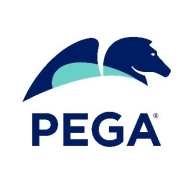

Pega Platform and Camunda both cater to enterprises, offering distinct functionalities. Pega seems to gain an upper hand due to its extensive feature set for handling complex processes efficiently, while Camunda appeals to developers with its open-source adaptability.
Features: Pega Platform is recognized for case management, robust integration capabilities, and low-code development, which facilitate swift enterprise deployment. It handles complex processes with ease. Camunda, on the other hand, offers open-source flexibility, integration with multiple programming languages, and a lightweight architecture suited for customization. Camunda is ideal for developers seeking to tailor workflows as needed.
Room for Improvement: Pega faces criticism for high licensing costs and complexity, which can result in a steep learning curve. Users also desire better integration with non-relational databases and more streamlined cloud solutions. Camunda lacks advanced GUI tools and comprehensive community support, and users request improved documentation and enhanced integration capabilities. Both systems strive to refine usability and integration.
Ease of Deployment and Customer Service: Pega offers deployment flexibility across cloud and on-premises environments with comprehensive support structures. However, complex issue responses can be lengthy. Camunda's community edition allows for flexible deployment across diverse systems. While community support may falter on complex queries, its open-source framework provides attractive customization options.
Pricing and ROI: Pega is seen as expensive due to its comprehensive feature set, leading to high licensing costs. Its ROI is justified by improved process efficiency. Camunda, being open source, provides a cost-effective alternative with licensing focused on support rather than usage, lowering entry costs.
AWS provides the best support, followed by Microsoft, and then Google.
They really understand deeply and in detailed fashion the solution.
They provide better support for the enterprise edition.
I never needed support from the platform standpoint, but if additional features are required, we have regular meetings with the product team for feedback.
The technical support from Pega is very low, rating a one or two out of ten.
Pega's technical support team is very helpful.
Camunda offers a high level of scalability, especially when using its SaaS model, which manages and scales implementations automatically.
ECS and Fargate make horizontal scalability very easy.
They have that REST layer, REST APIs layer that makes it easy to integrate and make it part of a microservices ecosystem and APIs.
Currently, big banking providers and insurance providers, even the members for healthcare payers, are using more than millions of operations on a daily or weekly basis.
There haven't been any significant outages in my experience with Camunda.
We were not really concerned about the performance on the process itself because it was super simple, super straightforward, and it did not present itself as a bottleneck, nor did we feel it was adding additional time in the execution.
More open documentation would be beneficial to understand the deployment process better and facilitate easier setup.
There is an issue where, in some situations, I need to scale up by observing both CPU and memory usage of containers, yet under the current options available at Amazon, this is not possible.
Since they made the move to cloud deployment in a more SaaS-oriented way, they do not invest too much in the community version.
Pega introduced Constellation, which allows a user to build a more engaging visual experience.
For customer interactions, while the Pega Platform's AI-based decisioning and predictive analytics are great, the Process AI is not very popular yet, as it works on process data rather than customer data.
My learning curve in robotics has been challenging.
AWS pricing is very competitive compared to Azure and cheap compared to Google.
There is a licensing cost for using the SaaS model and Enterprise edition of Camunda.
Pega is priced higher than open-source options like Flowable but is suitable for large-scale industries like banking and insurance.
The pricing is expensive, and this is an issue.
From a licensing perspective, it is higher than the competition.
EC2 makes scaling horizontally incredibly easy, especially when working under the ECS service.
Camunda's support for BPMN 2.0 is a great advantage because it allows us to have a common language to discuss technology and business in the same perspective.
The biggest difference between Camunda and Bonita might be that Camunda is simpler and more flexible for setting.
Management capabilities such as dashboards.
Pega Platform is excellent for enterprise-level solutions with integrations to entire systems, including case management, service orchestration, CRM, decision-making capabilities, digital process automation, and AI-driven functionalities.
| Product | Market Share (%) |
|---|---|
| Camunda | 14.0% |
| Pega Platform | 5.0% |
| Other | 81.0% |


| Company Size | Count |
|---|---|
| Small Business | 42 |
| Midsize Enterprise | 15 |
| Large Enterprise | 29 |
| Company Size | Count |
|---|---|
| Small Business | 9 |
| Midsize Enterprise | 15 |
| Large Enterprise | 68 |
Camunda revolutionizes process orchestration by enabling seamless automation and integration with AI, human tasks, and existing systems while ensuring security and governance.
Built for collaboration between business and IT, Camunda empowers organizations to manage complexity, boost efficiency, and maintain competitive advantage. With a clientele of over 700 top organizations like Atlassian, ING, and Vodafone, Camunda is a trusted partner in designing, orchestrating, automating, and refining critical business processes to accelerate digital transformation. Its open-source nature, ease of use, and REST API integration make it a versatile choice for various needs.
What are Camunda's key features?In banking, Camunda automates processes and manages transactions, while in telecommunications, it optimizes service orders. Governmental and public sectors benefit from workflow automation. Organizations often use either the enterprise edition or the open-source version to create APIs and manage business rules effectively.
Pega Platform provides flexible business process management with a focus on rapid application development and automation through a low-code approach, enhancing efficiency across sectors.
Pega Platform is renowned for its ability to streamline operations with robust automation features, including robotic process automation and decision-making capabilities. Its intuitive interface and workflow management contribute to a reputation for enhancing business processes. Although users face challenges with integration limitations and high licensing costs, they benefit from rapid deployment and efficient process adaptations. The unified architecture reduces complexity, while case management and integration services support digital transformations in sectors such as banking, insurance, and healthcare.
What are the key features of Pega Platform?In industries like insurance, banking, healthcare, and government, Pega Platform is implemented to automate diverse workflows, supporting initiatives from claims processing to customer onboarding. Enterprises use Pega for case management and digital transformations, valuing its out-of-the-box integrations and real-time reporting capabilities to boost operational automation and enhance customer experiences.
We monitor all Business Process Management (BPM) reviews to prevent fraudulent reviews and keep review quality high. We do not post reviews by company employees or direct competitors. We validate each review for authenticity via cross-reference with LinkedIn, and personal follow-up with the reviewer when necessary.